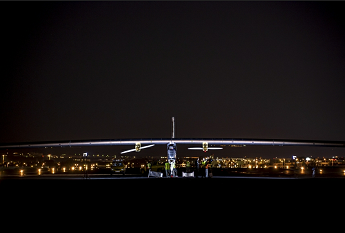Solar plane makes first intercontinental flight
 Yesterday, pilot Bertrand Piccard accomplished a landmark achievement that he hopes could lead to the reinvention of aviation technology: an intercontinental flight in a fully solar powered aircraft.
Yesterday, pilot Bertrand Piccard accomplished a landmark achievement that he hopes could lead to the reinvention of aviation technology: an intercontinental flight in a fully solar powered aircraft.It’s too early to tell whether the name Piccard will be as revered in the chronicles of aviation history as Charles Lindbergh, but he has proven that the sun’s energy is enough to keep a plane in the air day and night - carrying one person.
The plane originated in Switzerland, stopped over in Madrid due to a technical glitch, and then continued onward to Morocco. The 1,550-mile flight took 20 hours, according to a BBC News report. (Watch here for video).
Piccard is the president of Solar Impulse, the designers of the solar plane, which is close to the size of the 240+ passenger Airbus A340. A major difference is that Solar Impulse’s aircraft weighs the same as a family car due to its use of all carbon fiber components.
(Kudos to any Star Trek fans who also wished Piccard’s first name was Jean-Luc).
New technology is not without its growing pains. Boeing’s 787 Dreamliner plane is also made using a carbon fiber composite structure; however, its introduction has been plagued by production delays, worried whistleblowers, and mandatory inspections.
Meanwhile, most airlines are taking a more conventional approach to managing energy problems with existing aircrafts. Air China, Air New Zealand, British Airways, Continental Airlines, Japan Airlines, KLM, Lufthansa, United Airlines, and Virgin Atlantic are among those trialing biofuels on routes today.
The solar experiment will continue unabated against the biofuel trend. Solar Impulse is planning a flight around the world, culminating in a 2014 world tour. While the proof of concept is interesting, I have to wonder whether the technology is anywhere near ready for long-haul commercial duty.
You can return to the main Market News page, or press the Back button on your browser.

